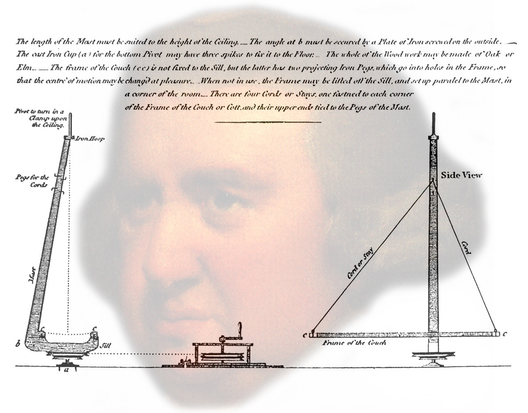Erasmus Darwin1731–1802
Darwin’s reputation was high during his life, but diminished in the century that followed, being eclipsed by the impact of his grandson, Charles. Erasmus Darwin studied medicine at Edinburgh University for two years from 1754, and practiced as a physician at Lichfield from 1756-1781. Darwin built a successful practice at Lichfield, but his interests were not confined to medicine. He formed friendships with major engines of the industrial revolution, like James Brindley, Matthew Boulton, James Watt, Josiah Wedgwood, and Joseph Priestley. From around 1765 onwards they met on the nearest Monday to the full moon; the group later became the Lunar Society of Birmingham. The final twenty one years of his life were spent practicing medicine at Derby. It was during this period that his fame as a poet and his authority as a physician were firmly established. Darwin’s epic poem on vegetable life, The Botanic Garden, was published in two parts in 1789 and 1791, and the two volumes of Zoonomia, dealing with animal life, appeared in 1794 and 1796. He commenced the first volume: “The purpose of the following pages is an endeavour to reduce the facts belonging to ANIMAL LIFE into classes, orders, genera, and species; and by comparing them with each other, to unravel the theory of diseases”. The theory was based on assessing the excess or deficiency of sensation, irritation, volition, or association. In the third edition of Zoonomia, published in 1801, Darwin described his invention of the human centrifuge; he called the device a rotative couch; he did not, however, construct one or perform experiments with it. The proposed function of the rotative couch was to increase pressure on the brain which was thought to have a calming influence. Detailed engineering drawings were made by Darwin’s friend, James Watt (1736-1819), and Darwin is shown with it. It is clear that Darwin’s device was not stimulated by his concern with vertigo, rather it was driven by his theory of disease, in which any means of inducing sleep was considered efficacious. The basis for Darwin’s invention of the rotating chair or bed might have been idiosyncratic but its subsequent application has been widespread, and it has provided the foundation on which much vestibular research has progressed. Darwin was alert to the advances made over a vast scientific spectrum. For example, he was amongst the first to apply galvanic (electrical) stimulation to the senses. He reported an experiment by Volta in which current from lead and silver in connection, when delivered to different parts of the tongue, resulted in “a saline or acidulous taste is perceived, as of a fluid like a stream of electricity passing from one of them to the other. This new application of the sense of taste deserves further investigation, as it may acquaint us with new properties of matter”. It is in Darwin’s poetic synthesis of art and science, The Temple of Nature, published after his death, that his ideas about evolution are most clearly formulated. In his vast interest on the phenomena of life Darwin also mentioned, in both prose and poetic form, the electric fishes (torpedoes and electric eels).
